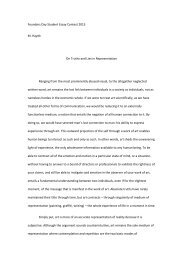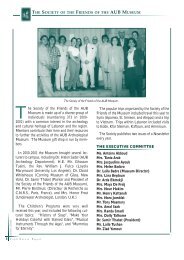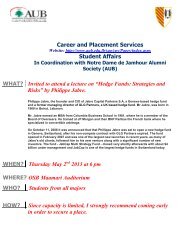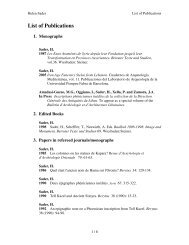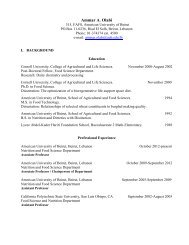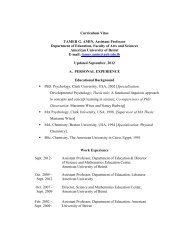The IX t h Makassed Medical Congress - American University of Beirut
The IX t h Makassed Medical Congress - American University of Beirut
The IX t h Makassed Medical Congress - American University of Beirut
You also want an ePaper? Increase the reach of your titles
YUMPU automatically turns print PDFs into web optimized ePapers that Google loves.
T h e I X t h M a k a s e d M e d i c a l C o n g r e s s<br />
Transcatheter Aortic Valve Implantation<br />
Samir R. Kapadia, MD<br />
E. Murat Tuzcu, MD<br />
Corresponding author<br />
E. Murat Tuzcu, MD<br />
Department <strong>of</strong> Medicine, Cleveland Clinic,<br />
9500 Euclid Avenue, J2-3, Cleveland, OH 44195, USA.<br />
E-mail: Tuzcue@ccf.org<br />
Current Treatment Options in Cardiovascular Medicine 2009, 11:467–475<br />
Current Medicine Group LLC ISSN 1092-8464<br />
Copyright © 2009 by Current Medicine Group LLC<br />
Opinion statement<br />
Aortic stenosis is the most important valvular heart disease affecting the elderly<br />
population. Surgical aortic valve replacement is the mainstay <strong>of</strong> treatment, although<br />
a substantial number <strong>of</strong> patients are considered high risk for surgery. Many <strong>of</strong> these<br />
patients do not undergo surgery and have poor outcomes from medically treated<br />
symptomatic, severe aortic stenosis. Transcatheter aortic valve implantation (TAVI)<br />
provides a promising treatment option for some <strong>of</strong> these patients. Several devices<br />
are under investigation. <strong>The</strong> Edwards Sapien valve (Edwards Lifesciences, Irvine,<br />
CA) and the CoreValve (Medtronic, Minneapolis, MN) have the largest human experience<br />
to date. Initial data suggest that these devices have an acceptable safety<br />
pr<strong>of</strong>i le and provide excellent hemodynamic relief <strong>of</strong> aortic stenosis. <strong>The</strong> Edwards<br />
Sapien valve is currently under investigation in the United States in the PARTNER<br />
(Placement <strong>of</strong> Aortic Transcatheter Valve) trial in high-risk surgical or inoperable patients;<br />
TAVI is available for clinical use in both Canada and Europe. TAVI is not used<br />
in low- or intermediate-risk surgical patients; however, future studies may prove<br />
its applicability in these subsets. <strong>The</strong> major complications <strong>of</strong> TAVI include access<br />
site–related problems and device malpositioning/migration. <strong>The</strong>re are several newgeneration<br />
prosthetic valves and delivery systems designed to be low pr<strong>of</strong>i le and repositionable.<br />
Technical advances and refi nement <strong>of</strong> the implantation methods may<br />
make TAVI even safer and ultimately a better treatment option, not only for patients<br />
with high surgical risk but also for those with moderate or low risk.<br />
Introduction<br />
Valvular heart disease has a signifi cant impact on<br />
cardiovascular mortality and morbidity [1–3]. Aortic<br />
stenosis (AS) is the most common valvular lesion in<br />
the aging population, with a prevalence <strong>of</strong> 4.6% in<br />
adults ≥ 75 years <strong>of</strong> age [2–4]. <strong>The</strong> advancing age <strong>of</strong><br />
the population, combined with the lack <strong>of</strong> pharmacologic<br />
therapies to prevent, halt, or effectively slow the<br />
progression <strong>of</strong> AS, has led to an even greater burden <strong>of</strong><br />
this disease in developed countries [1–3].<br />
Surgical aortic valve replacement (SAVR) is the recommended<br />
treatment for patients with symptoms [5].<br />
After the onset <strong>of</strong> symptoms, average survival may be<br />
as brief as 1 to 3 years without SAVR [5–9]. Within the<br />
United States, more than 50,000 aortic valve replacements<br />
(AVRs) are performed annually for severe AS.<br />
Many patients with severe symptomatic AS do not<br />
82<br />
undergo surgery for various reasons. Some are not<br />
referred for surgery because <strong>of</strong> comorbidities or patient<br />
preference; others are deemed inoperable by the surgeon<br />
because <strong>of</strong> the presence <strong>of</strong> coexisting illnesses. This issue<br />
is particularly the case with the elderly. In the Euro Heart<br />
Survey on valvular heart disease, 33% <strong>of</strong> patients with<br />
severe symptomatic AS did not undergo surgery [10].<br />
Other studies similarly have shown that 27% to 41%<br />
<strong>of</strong> patients with severe symptomatic AS do not undergo<br />
SAVR [9,11–13]. <strong>The</strong> advent <strong>of</strong> transcatheter aortic<br />
valve implantation (TAVI) provides a unique treatment<br />
option for some <strong>of</strong> these patients [14–19,20•,21].<br />
SAVR remains the gold standard <strong>of</strong> treatment for<br />
patients with low and intermediate surgical risk. However,<br />
the surgical risk is diffi cult to judge at times because<br />
several subjective variables may play critical roles in






